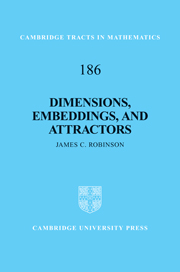Book contents
- Frontmatter
- Contents
- Preface
- Introduction
- PART I FINITE-DIMENSIONAL SETS
- PART II FINITE-DIMENSIONAL ATTRACTIORS
- 10 Partial differential equations and nonlinear semigroups
- 11 Attracting sets in infinite-dimensional systems
- 12 Bounding the box-counting dimension of attractors
- 13 Thickness exponents of attractors
- 14 The Takens Time-Delay Embedding Theorem
- 15 Parametrisation of attractors via point values
- Solutions to exercises
- References
- Index
12 - Bounding the box-counting dimension of attractors
from PART II - FINITE-DIMENSIONAL ATTRACTIORS
Published online by Cambridge University Press: 10 January 2011
- Frontmatter
- Contents
- Preface
- Introduction
- PART I FINITE-DIMENSIONAL SETS
- PART II FINITE-DIMENSIONAL ATTRACTIORS
- 10 Partial differential equations and nonlinear semigroups
- 11 Attracting sets in infinite-dimensional systems
- 12 Bounding the box-counting dimension of attractors
- 13 Thickness exponents of attractors
- 14 The Takens Time-Delay Embedding Theorem
- 15 Parametrisation of attractors via point values
- Solutions to exercises
- References
- Index
Summary
Powerful techniques are available for bounding the box-counting dimension of attractors in Hilbert spaces, the case most often encountered in applications. The most widely-used method was developed for finite-dimensional dynamical systems by Douady & Oesterlé (1980), and was extended to treat subsets of infinite-dimensional Hilbert spaces by Constantin & Foias (1985). Much effort has also been expended in refining the resulting estimates for particular models, in particular for the two-dimensional Navier–Stokes equations (for a nice overview see Doering & Gibbon (1995)).
However, general results providing bounds on the dimension of compact invariant sets go back to Mallet-Paret (1976), who showed that if K is a compact subset of a Hilbert space H, f : H → H is continuously differentiable, f(K) ⊇ K (‘K is negatively invariant’), and the derivative of f is everywhere equal to the sum of a compact map and a contraction, then the upper boxcounting dimension of K is finite. Mañé (1981) generalised this argument to treat subsets of Banach spaces (this was in the same paper in which he proved a ‘generic’ embedding theorem for sets with dH(X − X) finite, cf. our Theorem 6.2).
The Hilbert space method is already cleanly and clearly presented in a number of texts that concentrate more specifically on estimating the dimension of attractors (e.g. Chepyzhov & Vishik, 2002; Robinson, 2001; Temam, 1988), and a general technique that covers the Banach space case seems more in keeping with the rest of this book.
- Type
- Chapter
- Information
- Dimensions, Embeddings, and Attractors , pp. 123 - 135Publisher: Cambridge University PressPrint publication year: 2010

